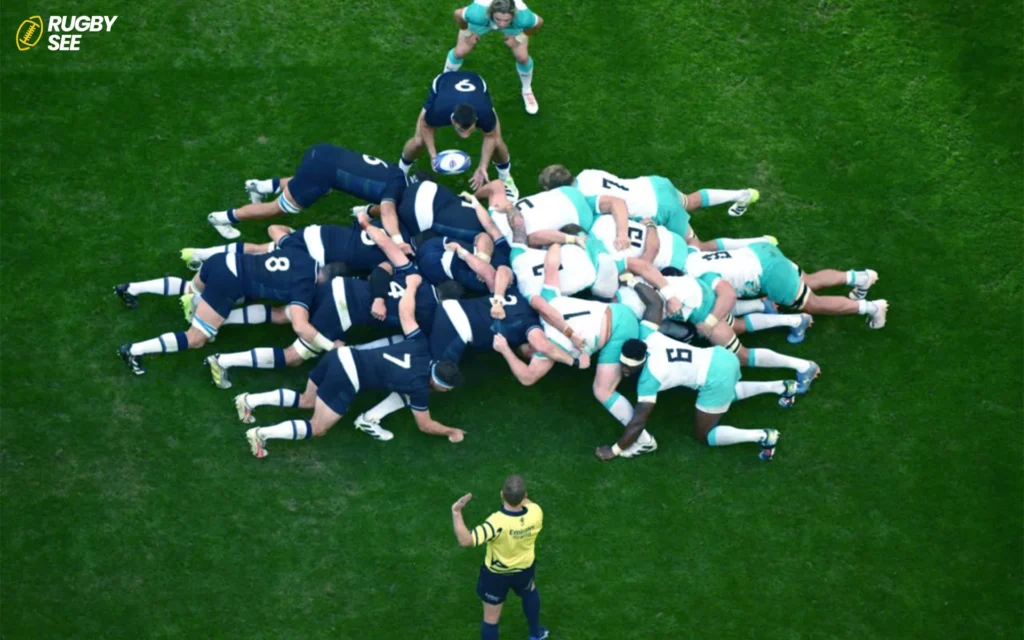Rugby, a sport famous for its combination of strategy, strength and group, has an important role in the individual that sets him apart. Meanwhile, the scrum is a central aspect of the game, a contest of power and trickery that can significantly influence the outcome of a game. In this guide with Rugbysee we will cover the rules of the rugby scrum and provide a clear and understandable breakdown for fans and players alike.
What Is a Scrum?
A scrum is a method of restarting play in rugby following minor infringements by the team in possession, such as a forward pass or a knock-on. It involves eight players from each team, known as the forwards, binding together and pushing against the opposing team’s assembled forwards in a contest for the ball.
The Players and Their Positions
The eight players in a scrum are divided into the front row, the second row, and the back row. Each has specific roles:
- Front Row: Two props (loosehead and tighthead) and the hooker. Their main job is to provide stability and secure the ball.
- Second Row: Two locks. They are the engine of the scrum, providing the power for the push.
- Back Row: Consists of two flankers and the number eight. They aim to control the ball once it’s in the scrum and provide additional support to the push.

Key Scrum Rules
Formation
The scrum must be formed at the place of infringement, with the teams bound together and heads interlocked, forming a tunnel for the ball to be introduced.
Engagement
The referee will call “crouch,” then “bind,” where the front rows must bind onto each other’s shoulders. Upon the referee’s command of “set,” the two packs engage. This sequence ensures safety and fairness.
Introducing the Ball
The scrum-half of the team awarded the scrum feeds the ball into the tunnel. The feed must be straight, allowing both teams an equal chance to contest the ball.
Contesting the Ball
The hookers contest the ball using their feet, trying to hook it back towards their own team. The rest of the players push forward, attempting to gain territory and secure possession.
Penalties and Free Kicks
Violations such as early engagement, collapsing the scrum, or illegal use of hands can result in penalties or free kicks against the offending team, emphasizing the importance of discipline and technique in scrum play.
The Importance of the Scrum
Scrummaging is not just about physical dominance; it’s a strategic element of rugby. Winning a scrum can provide a platform for launching attacks and can be a psychological advantage, demonstrating superiority in the forward pack. It also serves to concentrate the forwards in one area, creating space elsewhere on the field for the backs to exploit.

Safety First
Given the physical nature of scrums, rugby authorities have implemented strict rules to ensure player safety. Proper technique, engagement procedures, and referee oversight are crucial to preventing injuries. Players are trained extensively in scrum techniques from a young age to build skill and resilience.In this article, you will fully understand the scrum and its role in rugby. If you want to learn more about the scrum in rugby league raed What is the point of a scrum in rugby league article.
The Tactical Nuances of the Scrum
The scrum is not just a physical contest but a battle of wits and strategy. Teams often use the scrum to gauge the opposition’s strength, adjust their game plan, and exploit weaknesses. Coaches and players analyze scrums as key phases of play, planning specific moves to be executed off scrum wins.
Winning the Psychological Battle
A dominant scrum can significantly impact the morale of both teams. Winning a scrum against the head (securing the ball when the opposition is feeding it) is a considerable psychological victory, potentially shifting momentum in a closely contested match.
The Role of the Scrum-Half and Number Eight
While the front eight are crucial in securing and pushing within the scrum, the roles of the scrum-half and number eight are pivotal in controlling the ball once it’s in play. The scrum-half must accurately feed the ball and then quickly distribute it to the backs, while the number eight controls the ball at the back of the scrum, deciding when to release it to the scrum-half or make a break themselves.
Referee’s Role in the Scrum
The referee plays a vital role in ensuring the scrum is conducted safely and fairly. Before the engagement, the referee ensures both teams are ready, using commands to control the scrum’s formation and commencement. During the scrum, the referee watches for infringements such as collapsing the scrum, players standing up, or illegal binding. The safety protocols and rules are strictly enforced to minimize risk to players.Rugby scrum penalties are one of the most important debates in rugby league and if you want to find out more about this, read Unpacking Rugby Scrum Penalties: A Comprehensive Guide.
Evolution of Scrum Rules
Rugby’s governing bodies continually review and sometimes revise scrum rules to enhance player welfare, improve the game’s flow, and ensure fair competition. Recent years have seen adjustments in engagement procedures and stricter penalties for infringements, aiming to reduce collapses and resets which can lead to injuries and disrupt the game.

Training and Technique
Behind every powerful scrum is a regimen of rigorous training and technique refinement. Players spend countless hours perfecting their body positions, binding techniques, and coordination with teammates. This preparation is crucial, as even a minor lapse in technique can result in losing the scrum or, worse, injury.
The Scrum in Rugby Culture
The scrum encapsulates many of rugby’s core values: teamwork, respect, and discipline. It is a microcosm of the game itself, where collective effort and strategic thinking are paramount. The camaraderie formed in the scrum is emblematic of rugby’s spirit, where forwards, regardless of club or country allegiance, share a bond forged in the heat of this unique contest.
The rugby scrum is a fascinating blend of strength, strategy, and skill, essential to the sport’s character. Understanding the rules and roles within the scrum not only enhances appreciation of the game but also highlights the teamwork and discipline required to excel in rugby. Whether you’re a seasoned fan or new to the sport, the dynamics of the scrum underscore the complexities and allure of rugby, offering endless moments of excitement and tactical intrigue.










